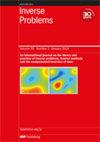A novel variational approach for multiphoton microscopy image restoration: from PSF estimation to 3D deconvolution
IF 2
2区 数学
Q1 MATHEMATICS, APPLIED
引用次数: 0
Abstract
In multi-photon microscopy (MPM), a recent in-vivo fluorescence microscopy system, the task of image restoration can be decomposed into two interlinked inverse problems: firstly, the characterization of the point spread function (PSF) and subsequently, the deconvolution (i.e. deblurring) to remove the PSF effect, and reduce noise. The acquired MPM image quality is critically affected by PSF blurring and intense noise. The PSF in MPM is highly spread in 3D and is not well characterized, presenting high variability with respect to the observed objects. This makes the restoration of MPM images challenging. Common PSF estimation methods in fluorescence microscopy, including MPM, involve capturing images of sub-resolution beads, followed by quantifying the resulting ellipsoidal 3D spot. In this work, we revisit this approach, coping with its inherent limitations in terms of accuracy and practicality. We estimate the PSF from the observation of relatively large beads (approximately 1 in diameter). This goes through the formulation and resolution of an original non-convex minimization problem, for which we propose a proximal alternating method along with convergence guarantees. Following the PSF estimation step, we then introduce an innovative strategy to deal with the high level multiplicative noise degrading the acquisitions. We rely on a heteroscedastic noise model for which we estimate the parameters. We then solve a constrained optimization problem to restore the image, accounting for the estimated PSF and noise, while allowing a minimal hyper-parameter tuning. Theoretical guarantees are given for the restoration algorithm. These algorithmic contributions lead to an end-to-end pipeline for 3D image restoration in MPM, that we share as a publicly available Python software. We demonstrate its effectiveness through several experiments on both simulated and real data.用于多光子显微镜图像复原的新型变分法:从 PSF 估计到 3D 解卷积
在多光子显微镜(MPM)这一最新的体内荧光显微系统中,图像修复任务可分解为两个相互关联的逆问题:首先是点扩散函数(PSF)的表征,然后是去卷积(即去模糊),以消除 PSF 效应并降低噪声。获取的 MPM 图像质量受到 PSF 模糊和强烈噪声的严重影响。MPM 中的 PSF 在三维空间中高度分散,特性不佳,与观测对象之间存在很大差异。这使得 MPM 图像的还原具有挑战性。荧光显微镜(包括 MPM)中常用的 PSF 估算方法包括捕捉亚分辨率珠子图像,然后量化由此产生的椭圆形三维光斑。在这项工作中,我们重新审视了这种方法,解决了其在准确性和实用性方面的固有局限。我们通过观测相对较大的珠子(直径约为 1)来估算 PSF。为此,我们提出了一种近似交替法,并提供了收敛保证。在 PSF 估计步骤之后,我们引入了一种创新策略来处理影响采集效果的高水平乘法噪声。我们依靠一个异速噪声模型来估计参数。然后,我们解决了一个约束优化问题,以恢复图像,同时考虑到估计的 PSF 和噪声,并允许最小的超参数调整。我们给出了还原算法的理论保证。通过这些算法的贡献,我们在 MPM 中建立了端到端的 3D 图像修复管道,并将其作为一个公开的 Python 软件与大家分享。我们通过对模拟数据和真实数据的多次实验证明了该软件的有效性。
本文章由计算机程序翻译,如有差异,请以英文原文为准。
求助全文
约1分钟内获得全文
求助全文
来源期刊

Inverse Problems
数学-物理:数学物理
CiteScore
4.40
自引率
14.30%
发文量
115
审稿时长
2.3 months
期刊介绍:
An interdisciplinary journal combining mathematical and experimental papers on inverse problems with theoretical, numerical and practical approaches to their solution.
As well as applied mathematicians, physical scientists and engineers, the readership includes those working in geophysics, radar, optics, biology, acoustics, communication theory, signal processing and imaging, among others.
The emphasis is on publishing original contributions to methods of solving mathematical, physical and applied problems. To be publishable in this journal, papers must meet the highest standards of scientific quality, contain significant and original new science and should present substantial advancement in the field. Due to the broad scope of the journal, we require that authors provide sufficient introductory material to appeal to the wide readership and that articles which are not explicitly applied include a discussion of possible applications.
 求助内容:
求助内容: 应助结果提醒方式:
应助结果提醒方式:


